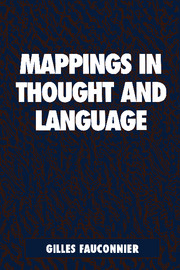5 - Matching
Published online by Cambridge University Press: 05 June 2012
Summary
One way to think of space building, as determined by linguistic and non-linguistic features of the ongoing discourse and discourse setting, is to view the configurations as imposing constraints on available interpretations and subsequent configurations. There is an array of operators, such as if, when, where, or, whenever, supposing that, which are understood to open spaces and impose matching conditions on related spaces.
Matching and Structure Projection
We shall say quite generally that space M with structure µ matches space N with structure ν via connector C, if structure µ can be mapped by connector C onto a substructure of ν. Two distinct questions arise: (1) the specification of the matching conditions; (2) what spaces are subject to the matching constraints, and what connectors are involved?
We shall first consider (1). Matching operators open two new spaces, a foundation space and an expansion space. The expansion is subordinate to the foundation (see Fig. 5.1).
Let me illustrate the concept with the operator if. At some stage in the discourse construction, an expression of the form
If A, then B
is introduced, relative to a space M in focus. A foundation space F subordinate to M is constructed by applying the instructions of language expression A. An expansion space E subordinate to F is constructed by applying the instructions of B to a copy of F.
- Type
- Chapter
- Information
- Mappings in Thought and Language , pp. 131 - 148Publisher: Cambridge University PressPrint publication year: 1997



